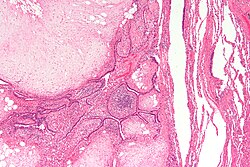Hamartoma
Jump to navigation
Jump to search
- Disorganized (non-neoplastic) growth (that may mimic a true neoplasm).
- May be clonal.
- May have recurrent genetic translocations.
- Composed of tissue of the region within it is found.
Note 1
- If #2 does not apply it is a choristoma.
- "Disorganized" in #1 separates it from:
- Hypertrophy and hyperplasia - which may be physiologic processes.
- The key differences between cancer and hamartoma are the ability of cancer to:
- Invade/destroy surrounding tissue.
- Metastasize.
- Considered clinically, growth is the difference between a benign tumour (measurable growth rate) and a hamartoma (no growth vis-à-vis the surrounding tissue).
- Hamartomas often consist of:
- Multiple cell types, e.g. Peutz-Jeghers polyps consist of normal submucosal elements.
- Have a well-circumscribed border.
Note 2
There is much confusion in this area as:
- Clonality is usually considered a characteristic of neoplasms.
- The line between benign tumour and hamartoma is thin, if one considers that a hamartoma can be clonal and some benign tumours have a slow growth rate.
- If one considers choristoma (hamartoma's cousin), the line between benign tumour (e.g. teratoma/dermoid cyst) and choristoma is thin.
A more useful definition of hamartoma might be:
- Architecturally disorganized tissue that appears to be native to the site.
- No significant growth (vis-à-vis the surrounding tissue).
Site specific
- Mammary hamartoma.
- Pulmonary hamartoma.
- Splenic hamartoma.
- Neurocristic hamartoma.
- Peutz-Jeghers polyp.
- Fibrous hamartoma of infancy.
See also
References
- ↑ URL: http://www.medterms.com/script/main/art.asp?articlekey=84157. Accessed on: 22 November 2010.
- ↑ Mitchell, Richard; Kumar, Vinay; Fausto, Nelson; Abbas, Abul K.; Aster, Jon (2011). Pocket Companion to Robbins & Cotran Pathologic Basis of Disease (8th ed.). Elsevier Saunders. pp. 147. ISBN 978-1416054542.
